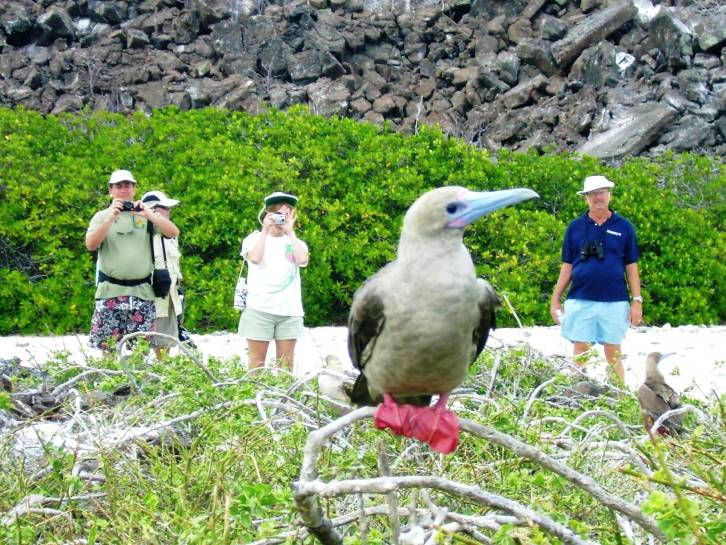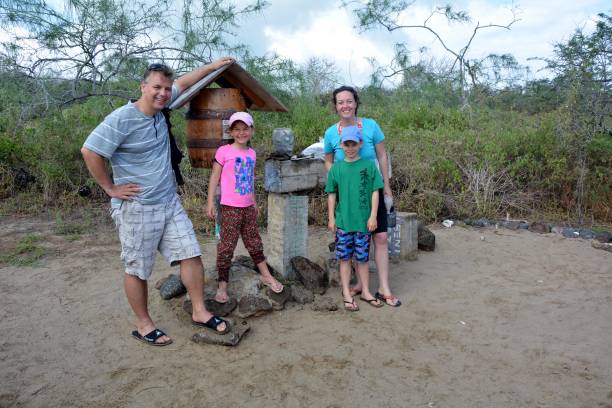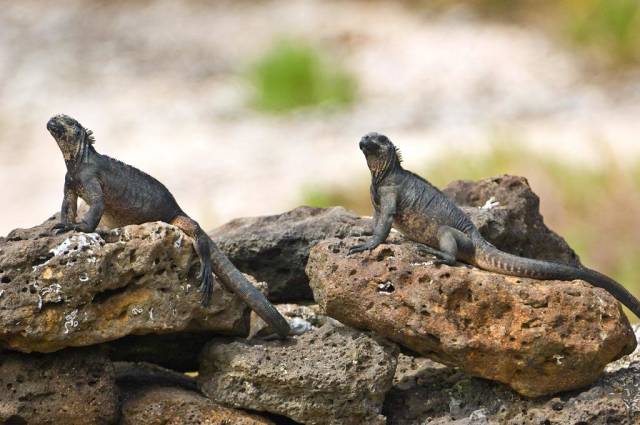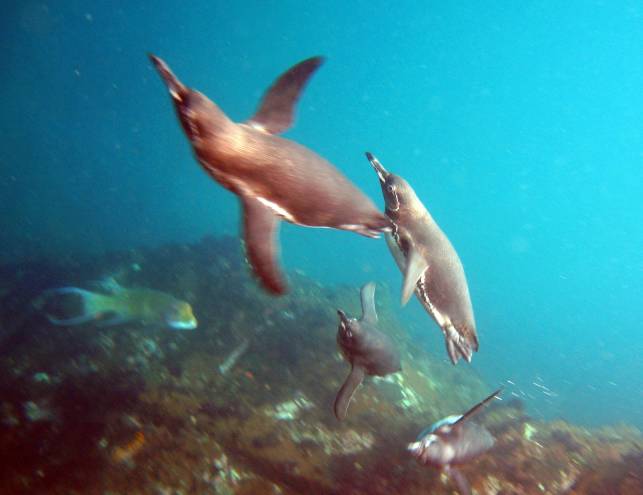As word of the remarkable diversity of Galapagos Islands animals continues to spread, the Ecuadorian archipelago has emerged as one of the world’s most popular ecotourism hotspots.
In recent years the area has attracted over 150,000 annual visitors on average, most of them concentrated on San Cristobal and Santa Cruz Islands. As a means of limiting the negative impacts of mass tourism, the Galapagos National Park Authority established new rules in 2011. These regulations changed the route frequencies of Galapagos cruises, which encouraged tour operators to visit some of the lesser-known islands in the area.
Having taken a Galapagos cruise before and after the changes were implemented, I personally felt they were ultimately for the better. Not just for the local ecosystems and residents, but for travelers as well. It meant smaller crowds, better animal interactions, and opportunities to visit off-the-beaten-path attractions that land-based travelers never get to see.
Here’s a look at seven unique experiences only small-ship Galapagos cruises can offer:

Get a Bird’s-Eye-View on Genovesa Island
The Galapagos Islands is a world-renowned haven for bird lovers, because it boasts around 56 native species (45 of which are endemic) and 29 migratory species. But Genovesa, which is nicknamed “Bird Island,” is remarkable for providing a chance to see so many of them within a very short walking distance.
The island spans five square miles, and includes a great hiking trail at Prince Philip’s Steps. But the most intense action for us happened right near the horseshoe-shaped beach. We didn’t walk more than a few hundred yards in total, yet the diversity of birds we saw along the way was positively mind-blowing.
In a span of a few hours we saw Darwin’s finches, a Galapagos hawk, Galapagos mockingbirds, magnificent frigates, Nazca and red-footed boobies, swallow-tailed gulls, storm petrels and more. There were babies and juveniles nesting right alongside the trail, not to mention the ubiquitous Galapagos sea lions. As a wildlife photographer, it was one of the greatest days of my life!

Mail a Postcard at Post Office Bay on Floreana Island
Floreana is a fascinating island. In the 1920s, Ecuador encouraged colonists to set up homesteads in the Galapagos by offering free plots of land, hunting and fishing rights, and no taxes for the first 10 years. Some Europeans answered the call to start over in paradise, including numerous German expats looking to escape the dramatic political and economic instability of their homeland.
Floreana became the site of the notorious “Galapagos Affair” murder mystery. But its human presence dates back to the whaling era of the 1800s, when sailors set up a barrel in what became known as Post Office Bay. The homesick whalers (who were often at sea for years at a time) would leave letters to home there. Other passing sailors would deliver the letters to their ports of call.
The tradition continues today: Thousands of people travel to Galapagos and visit Post Office Bay each year, leaving postcards or letters for friends and family. Other visitors will deliver them to the intended recipient, sometimes by hand!

Marvel at Marine Iguanas on Fernandina Island
This endemic species can be found pretty much everywhere in the Galapagos. But they really seem to love congregating on the islands’ lava-strewn shores, where they can rapidly absorb heat from the sun to warm their bodies after a swim.
In terms of sheer numbers, the best place to see marine iguanas is Fernandina Island, where you’ll find hundreds of them gathered en masse. Up close they look a little like miniature Godzillas, hissing and sneezing in order to expel excess salt from their nasal glands.
Their flattened tails, shortened snouts, and spiky dorsal fins make them a wonder to behold in the water. It’s bizarre to be snorkeling and see a three-foot long lizard feeding on algae and seaweed 25 feet below you, then shimmying its prehistoric-looking body to swim to the surface for air. They’re an odd mixture of creepy, cuddly, and cool.

Swim with Galapagos Penguins on Isabela Island
Located directly across from Fernandina on Isabela Island, Tagus Cove is another Galapagos attraction with historic ties to sailors. This natural harbor was used by whalers and pirates centuries ago, and many of them either carved or painted the names of their ships on the surrounding rocks.
But these days Tagus Cove is better known as one of the best places in the Galapagos for snorkeling, especially if you want to see the rare Galapagos penguin. Swimming with Galapagos penguins isn’t easy: You’ll most often see them zipping through the water like turbo-fueled rockets, racing to run down favored prey such as krill, small crustaceans, and fish.
But if you’re lucky and keep a respectful distance, you might just find a penguin curious enough to swim around you for a closer look. We spent nearly 25 minutes swimming with a pair during our Galapagos cruise, and it remains one of the greatest wildlife encounters of my life.
Visit the Sea Lion Colony on Española Island
Visiting Gardner Bay on Española Island remains one of my favorite Galapagos Island experiences. The setting couldn’t possibly be more picturesque, with gorgeous white sand, brilliant blue waters, and stunning rock formations just offshore.
But the main attraction here is the huge Galapagos sea lion colony, which typically ranges from dozens to over a hundred animals. You’ll see baby sea lions feeding contentedly; adolescents frolicking in the surf; mamas watching over their young; and massive males battling for territory and breeding rights.

See the Unique Wildlife Around Wolf Volcano
Much like the Hawaiian Islands, the volcanic Galapagos archipelago is thought to have been created by a mantle plume. Situated on the north end of Isabela Island, Wolf Volcano is the area’s tallest peak (5,600 feet), and erupted in 2015 after 33 years of inactivity.
Named after 19th century German geologist Thomas Wolf, what’s most interesting about the volcano is the fact that the wildlife around it is incredibly unique. Not only from that of other islands in the archipelago, but from that of neighboring volcanoes on Isabela Island!
Its has its own subspecies of Galapagos tortoise, Chelonoidis nigra becki, which has a saddleback shell. It has other tortoise subspecies that were abandoned there over the years, including some with DNA similar to the late Lonesome George’s. Scientists are now attempting to use that DNA to bring back the extinct Pinta Island Tortoise. It’s also home to the rare pink land iguana, a new species discovered there in 2009.
It’s an incredible place to take a selfie, snorkel, or simply sit and watch one of the most beautiful sunset vistas we’ve ever been fortunate enough to see.
Dive Off the Coast of Wolf Island
Due to its unique, extraordinarily diverse array of marine life, the Galapagos Islands is one of the world’s most popular diving destinations. But some of its most impressive dive sites are also among its most remote.
Take Shark Point, off the coast of Wolf Island, as an example. It’s located some 100 miles northwest of Isabela. It has no permanent population, and the Galapagos National Park authority does not allow boats to land there. In short, a Galapagos cruise boat is the only way to visit.
But the Scuba diving there is world-renowned. Divers are primarily drawn by the massive whale sharks that inhabit the area. But you can also find large numbers of marine animals such as dolphins, Galapagos sharks, and hammerhead sharks. Just keep in mind that, due to strong currents and limited visibility, this site is recommended for experienced divers only.

